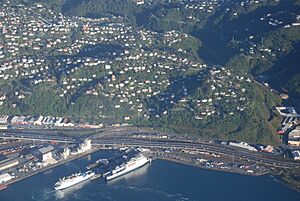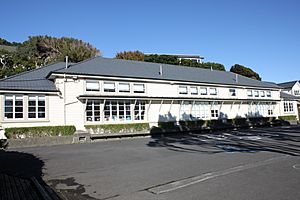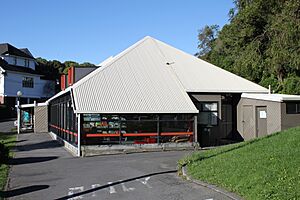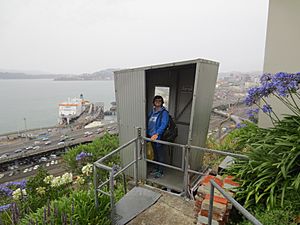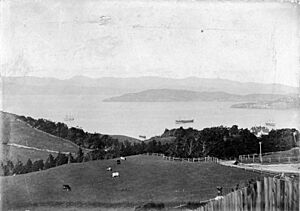Wadestown, New Zealand facts for kids
Quick facts for kids
Wadestown
|
|
|---|---|
|
Suburb
|
|
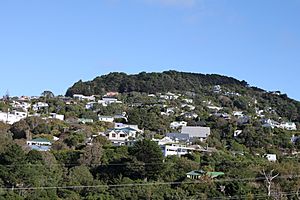
Wadestown and Te Ahumairangi Hill, looking from Ngaio
|
|
| Country | New Zealand |
| Local authority | Wellington City |
| Electoral ward |
|
| Area | |
| • Land | 144 ha (356 acre) |
| Population
(June 2023)
|
|
| • Total | 3,810 |
|
|
||
Wadestown is a northern suburb of Wellington, which is the capital city of New Zealand. It's located about 2 to 3 kilometers by road from Wellington's main city area and the New Zealand Parliament Buildings.
This area is mostly residential, meaning people live in houses here. It sits on the northern side of Te Ahumairangi Hill (which used to be called Tinakori Hill). From Wadestown, you can look down over Thorndon and the Ngaio Gorge. Wadestown is quite hilly, and one of its streets, Weld Street, is said to be one of the steepest in Wellington! The streets in Wadestown are narrow and charming, originally made by hand with picks, shovels, horses, and scoops.
Contents
How Wadestown Started
Wadestown was actually the very first suburb of Wellington. It got its name from a man named John Wade, who arrived in Wellington in 1840. In 1841, John Wade and another early settler, James Watt, bought land in this area. They then divided the land into smaller sections for people to buy. The streets Wade Street and Watt Street are named after them.
Who Lives in Wadestown?
Wadestown covers an area of about 1.44 square kilometers. It has an estimated population of 3,810 people as of June 2023, . This means there are about 2646 people living in each square kilometer.
| Historical population | ||
|---|---|---|
| Year | Pop. | ±% p.a. |
| 2006 | 3,549 | — |
| 2013 | 3,516 | −0.13% |
| 2018 | 3,753 | +1.31% |
In 2018, Wadestown had a population of 3,753 people. This was an increase of 237 people since 2013. There were 1,398 households, with slightly more females than males. The average age of people living here was about 38 years old. About 19% of the population was under 15 years old.
Most people in Wadestown (about 91%) are of European descent. There are also people from Māori, Pasifika, and Asian backgrounds, as well as other ethnicities. About 26% of the people living in Wadestown were born outside of New Zealand.
When asked about their religious beliefs, most people (about 61%) said they had no religion. About 29% were Christian, and smaller numbers followed other religions like Hinduism, Islam, or Buddhism.
Many adults in Wadestown (about 61%) have a university degree or higher qualification. The average income in Wadestown is higher than the national average. Most adults (about 61%) work full-time.
Wadestown's Borders
Wadestown has clear boundaries that separate it from other suburbs. To the south, it borders Thorndon. Its eastern boundary runs above the Hutt Road and into the Ngaio Gorge, following the Kaiwharawhara stream. To the west, it borders Wilton. The southern boundary goes along Weld Street and above Wade Street, heading towards Thorndon.
Learning in Wadestown
Wadestown has several options for education, from pre-school to high school.
School Zones
Students living in Wadestown can attend several high schools, including Wellington High School, Wellington College, Wellington Girls' College, and Onslow College. For primary school, most children go to Wadestown School. Some parts of Wadestown, like Highland Park, are also in the zone for Thorndon School.
Wadestown School
Wadestown School is a public school for children from Year 1 to Year 8 (ages 5 to 13). It has about 248 students as of February 2024. The school is spread across two campuses, which are about 1 kilometer apart.
The Weld Street campus is for the youngest students (Years 1-2). It has a playing field, a playground, gardens, and a small swimming pool.
The Rose Street campus is for students from Year 2 to Year 8. It's built on a hilly site with classrooms on different levels. This campus has a large flat playground, a playing field, gardens, and tennis courts.
Most students at Wadestown School come from the local area, but some also travel from nearby suburbs like Wilton, Chartwell, Thorndon, Khandallah, and Crofton Downs. The school has a special zone system for enrolments.
Wadestown School first opened on June 1, 1881, making it one of Wellington's earliest state schools. The Rose Street campus opened later in 1917. Both campuses have been updated and expanded many times over the years.
Pre-school Options
For younger children, Wadestown has a kindergarten called Wadestown Kindergarten. There's also the Wadestown Playgroup, which offers fun activities for children under 5 at the local playground and Plunket rooms.
Community Hubs
Wadestown has places where the community can gather and connect.
Local Library
Wellington City Libraries has a branch library in Wadestown. It's located on Philip Myers Park, which used to be a landfill but is now a green space.
Community Centre
The Wadestown Community Centre is on Pitt Street. Many local groups use this center, including the Wadestown Toy Library, where families can borrow toys.
Getting Around Wadestown
There are different ways to travel in and out of Wadestown.
Bus Services
Wadestown is served by the No. 14 Wilton bus route, making it easy for residents to travel to other parts of Wellington.
Tram History
Wellington used to have a tram system, and Wadestown was part of it from 1911. A narrow and steep path on Lennel Road was specially made for the trams. An old tram shelter from around 1918 still stands at the corner of Sefton Street and Hosking Lane/Lennel Road. It's now used as a bus shelter and is kept because of its historical importance. The tram line in Wadestown closed in 1949 and was replaced by buses.
Train Access
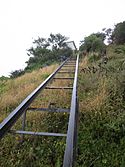
There isn't a train station directly in Wadestown. However, the Johnsonville train line runs along the lower slopes of Wadestown, above the Ngaio Gorge. This line was once part of the main railway route out of Wellington. The closest train station for Wadestown residents is Crofton Downs. Sometimes, the steep hillsides in Wadestown can cause issues for the commuter train service in the valley below.
Churches in Wadestown
Wadestown has two main churches: Wadestown Presbyterian and St Lukes Wadestown (Anglican). Both churches are on Wadestown Road and have been part of the community since 1881. There was also a Catholic church, St Brigid's, built in 1910, but it closed in 2007 and was turned into homes.
The Wadestown Presbyterian Church building had to close for a while in 2012 because it needed to be strengthened against earthquakes. It reopened after repairs, but in 2023, the church closed permanently.
Northern Walkway
A part of Wellington's Northern Walkway goes through Wadestown. This walking path starts at the Kaiwharawhara stream in Trelissick Park, goes up Hanover Street and Weld Street, and then onto Te Ahumairangi Hill. This section of the Northern Walkway is also part of Te Araroa, a national walking trail that stretches across New Zealand.
Historic Places in Wadestown
Wadestown is home to several places with interesting histories.
Highland Park Estate
Highland Park was once a large estate owned by W. B. Rhodes, who was known as "the richest man in New Zealand." His home, The Grange, was located here and overlooked the harbor. Rhodes bought Highland Park before 1849. After his widow passed away in 1914, the land was divided into smaller sections for housing. This led to the building of many high-quality homes.
Some of the streets in Highland Park are named after members of the Rhodes family, like Barnard Street, Anne Street, Sar Street, Sefton Street, and Moorhouse Street. Watt Street, named after James Watt, is even older. The Lennel Road cutting, with the Watt Street bridge, was made for the tramway in the early 1900s.
Fort Buckley
Fort Buckley is located on a steep hill below Barnard Street, with views of Wellington harbor. It was built in 1885 because people were worried that Russia might try to expand its empire in the South Pacific. This was the first fort that could defend Wellington's port from a naval attack. It's very important historically because its gun battery is one of the best-preserved examples of the defenses built in the late 1800s. Fort Buckley was part of a larger network of coastal defenses built at that time, showing that New Zealand was becoming more independent from Britain in military matters.
Heritage New Zealand recognized Fort Buckley as a Category 1 historic place in 2004. Today, it's a recreation area managed by a local association and the Wellington City Council.
Salisbury Garden Court
- Further information: Courtyard housing
Salisbury Garden Court is a unique group of 16 houses built in pairs around a tennis court. They are located on Cecil Road, near the top of Te Ahumairangi Hill. What makes this area special is the central court, the surrounding bush, and the very steep, pedestrian-only access. Built in 1929–30, the houses were designed with "Garden City" ideas in mind, focusing on community and green spaces. The Wellington City Council has named Salisbury Garden Court a Heritage Area.
During tough times like the Great Depression and World War II, the tennis court was a central place for activities. In the 1950s, many Polish families, who had arrived as child refugees in 1944, lived here, making it feel like a "Polish village." Later, in the 1970s, it became known for a "hippy commune." A documentary film called "A Place to Stay" was made in 2009 about the special design and interesting social history of Salisbury Garden Court.
No. 4 Goldies Brae
Another historic place, though now just inside the Thorndon boundary, is the house at 4 Goldies Brae. It was designed by its first owner, Dr. Alexander Johnston, and built in 1876. People often call it the "banana house" because of its curved shape. Some reports say its unique design was inspired by Gatcombe Park, a British stately home.
The house is unusual because it has a continuous glass gallery or conservatory that connects all ten rooms. This gallery helps to warm the rest of the house using solar heat. Heritage New Zealand has given this house a Category 1 historic listing. Silston Cory-Wright, a notable engineer, lived in this house for many years.
The Goldie's Brae estate was once much larger, including the area now covered by Grosvenor Terrace and parts of Orchard Street.
Onslow Borough History
Until April 1907, Wadestown was part of the Borough of Onslow. This borough also included areas like Ngaio and Khandallah. It was difficult to build proper drainage for Wadestown's houses within Onslow's boundaries. Also, the residents of this steep area wanted to be connected to Wellington's tramway system. Because of these reasons, Wadestown joined Wellington City in April 1907.
Famous People from Wadestown
Many interesting people have grown up, lived, or worked in Wadestown, including:
- William Barnard Rhodes (1807?–1878) – A successful New Zealand businessman and politician.
- Elsdon Best (1856–1931) – A well-known expert on Māori culture and history.
- Joseph Firth (1859–1931) – A headmaster of Wellington College.
- Heather Roy – A politician.
- Lily May Atkinson (1866–1921) – A campaigner for women's rights and temperance.
- Silston Cory-Wright (1888–1976) – An engineer and company director.
- Clarence Edward Beeby (1902–1998) – An important educationalist and public servant.
- Sylvia Ashton-Warner (1908–1984) – A famous educationalist, teacher, and writer.
- Ray Henwood (1937–2019) – An actor and co-founder of Circa Theatre.
- Dame Carolyn Henwood – A judge and co-founder of Circa Theatre.
- Elizabeth Knox (1959–present) – A well-known writer.
- Ian Foster (1959 – present) – A leading computer scientist.
- Sean Plunket (1964 – present) – A New Zealand journalist.
- Dai Henwood (1978 – present) – A popular comedian.



